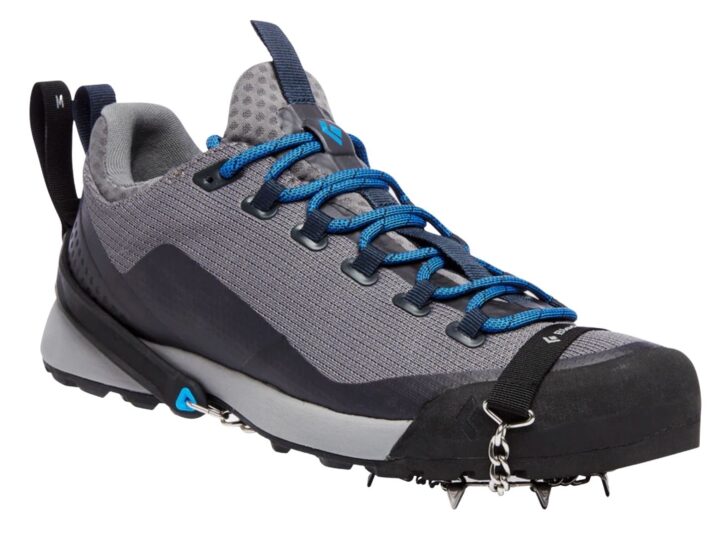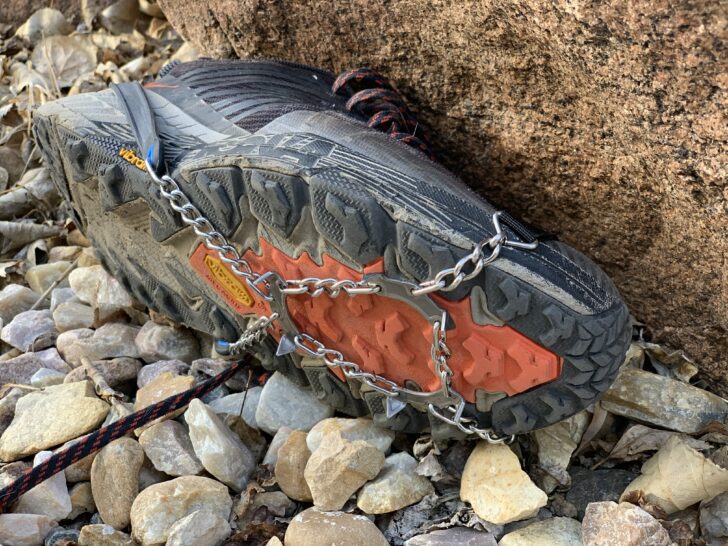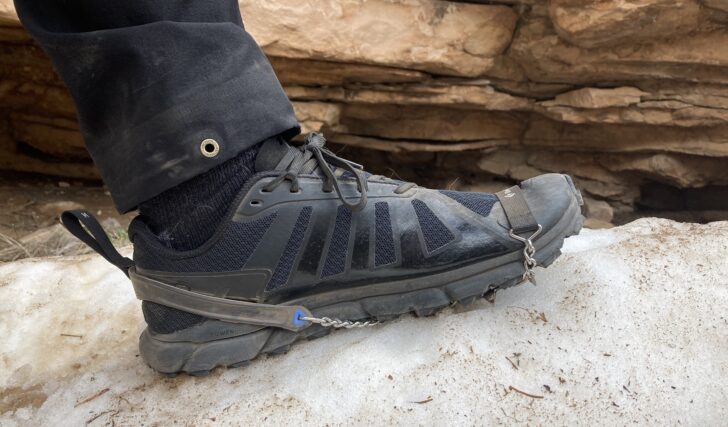Introduction
The Black Diamond Blitz Traction Spikes (MSRP $39.95, 1.5 to 1.8 oz / 42 to 50 g) are ultralight, stainless-steel, forefoot-only traction devices for shoes and boots intended for incidental use on hard-packed snow terrain.

Highlights
- multiple sizes (S, M, L, and XL) covering the range of US shoe sizes from Women’s 4 to Men’s 14.5
- forefoot spikes only (6)
- 8 mm spike length
- secured by a nylon webbing toe loop and elastomer band around the back of the heel
Testing Context
Our favorite time of year to hike is during the winter, and I have thousands of miles of hiking under my belt wearing spike-style traction devices of one sort or another. I come from a mountaineering background, so I’m pretty in tune with the performance of any type of traction device that helps me quickly and safely cross snow and ice. Through the years, I’ve accumulated an embarrassingly large amount of crampons and traction spikes suitable for ice climbing, trail running, and everything in between. And I discuss traction devices and their appropriate use as matched to the terrain in our recent webinar Lightweight Footwear and Traction Systems for Snow Travel.
I tested the Black Diamond Blitz Spikes on a number of trips in the mountains of Southeast Wyoming and Northern Colorado during the winter and spring months. I spent most of my time on packed snow trails, transitioning to mixed terrain (snow/water ice/dirt) as spring rolled around. As of this review, I have about 50 miles of experience with them while carrying an overnight backpack (20 to 40 lb / 9 to 18 kg) over terrain with slope angles of up to about 25 degrees.
I paired the Black Diamond Blitz Spikes with the following footwear:
- Scarpa Zen Pro II Approach Shoes
- Hoka Speedgoat Mid GTX Hiking Boots
- Hoka Speedgoat Trail Running Shoes
- Scarpa Marmolada Mountain Boots
- Inov-8 G270 Trail Running Shoes
Most often, I would wear the Blitz on one foot and another traction device on the other, so I could make direct comparisons. The comparison devices were usually the Black Diamond Distance Spikes, the Kahtoola Microspikes, or the Hillsound Trail Crampons.
First Impressions
Small Size
The most notable feature of the Black Diamond Blitz Spikes is their diminutive size. They are so small and light that I wouldn’t give a second thought about tossing them in my pack for the just-in-case scenario of having to inch my way over a snowy, moderately steep mountain pass during early season summer travel.
The Black Diamond Blitz Spikes are the first traction device I’ve used that I literally stuffed into my pants and jacket pockets, or my front accessory pack. They are so small that you have multiple storage options when not in use.
Short Spikes
The individual spikes on the Blitz are 8 mm long. They seem tiny compared to the 12 mm long spikes on Kahtoola Microspikes. Shorter spikes have two important impacts that are noticeable in the field:
- When wearing them on bare ground (e.g., dirt) and moving fast, my forefoot caught on the terrain underneath far less often than when I was wearing Kahtoola Microspikes. This is a big advantage, especially for trail running or at the end of the day when my legs are tired and my coordination is compromised.
- When climbing (and descending) steep, snowy (or muddy) terrain, the short spikes of the Blitz don’t have as much purchase (grip) as the Kahtoola Microspikes. If you have to rely on a totally secure grip on steep terrain where a fall is an issue, you may need a more aggressive traction device than the Blitz.
Ease of Use
Two straps – a nylon toe strap (webbing) and an elastomer heel strap – make these the easiest set of traction spikes to put on and take off my shoes that I’ve ever used. A nice-sized grab loop in the back makes the process intuitive and easy.
Footwear Applicability
The Blitz performs best (and perhaps, most sensibly) when mated to ultralight footwear. I had no issues when I used them with my Hoka Speedgoat trail running shoes and Speedgoat GTX mid-height boots. When I paired them with my stiffer approach shoes (the Scarpa Zen Pro II), the fit was secure and the spikes remained stable on the shoe even on steep terrain. However, when I paired them with a stiffer mountain boot (Scarpa Marmolada), the boot seemed to overpower the Blitz Spikes, causing them to shift position on the sole of the boot while sidehilling on steep terrain.
Photos




The Takeaway
Tiny size, truly ultralight, and speed (ease) of taking them off and putting them on are the hallmark features of the Black Diamond Blitz Spikes. I imagine they will remain in my ultralight backpacking kit for mountain travel until the snow melts out of the high passes, and I plan to use them for most of my trips this year in the Colorado Rockies and High Sierra.
Where to Buy
- Purchase Link: Black Diamond Blitz Traction Spikes
Related Content
- Webinar: Lightweight Footwear and Traction Systems for Snow Travel
- Read Emylene VanderVeldon’s review of the Hillsound Trail Crampon Ultras
DISCLOSURE (Updated April 9, 2024)
- Product mentions in this article are made by the author with no compensation in return. In addition, Backpacking Light does not accept compensation or donated/discounted products in exchange for product mentions or placements in editorial coverage.
- Some (but not all) of the links in this review may be affiliate links. If you click on one of these links and visit one of our affiliate partners (usually a retailer site), and subsequently place an order with that retailer, we receive a commission on your entire order, which varies between 3% and 15% of the purchase price. Affiliate commissions represent less than 15% of Backpacking Light's gross revenue. More than 70% of our revenue comes from Membership Fees. So if you'd really like to support our work, don't buy gear you don't need - support our consumer advocacy work and become a Member instead.
- Learn more about affiliate commissions, influencer marketing, and our consumer advocacy work by reading our article Stop wasting money on gear.




Home › Forums › Black Diamond Blitz Spikes Review